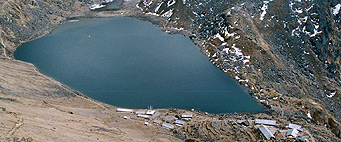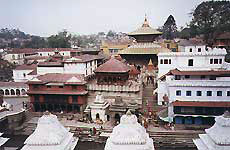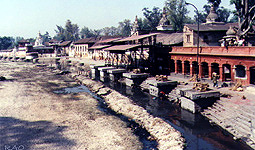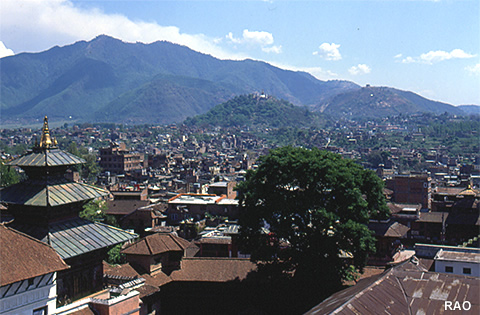 |
Bhimeshwor: Bhimsen Dolkha Hindu-Temple |
About 133 kilometers from Kathmandu, Charikot provides a spectacular mountain view of Gaurishankar. In the eastern upper part of Dolkha township there is a famous roofless temple of Dolkha Bhimsen.
 |
According to the religious and popular belief it is considered a bad omen (especially for the Royal family) if the stone idol of Dolkha Bhimsen "sweats" on its left side.
In 1990 the Bhimsen statue sweated a number of times. And according to the beliefs, it was one of the reasons why the years were ominous for the former Royal family. As per the traditions the sweat of the idol is wiped with pieces of cotton and it is believed that keeping these pieces of soaked cotton in one's home brings in good luck. |
|
 |
Gosainkund |
 |
| The
lake is believed to have been created by Lord Shiva, when he thrust his
trident into a mountain to draw water so that he could cool himself after
swallowing poison that burned his throat. There is a large rock at the
centre of the lake, which is said to be the remains of a Shiva shrine.
Gosainkund (altitude 4,380 m) is situated to the north of Kathmandu on
the Langtang trekking trail. |
|
The
holy lake is a two day trek from Dhunche (1,950 m), which is reached over
an adventurous 118 km mountain road from Kathmandu via Trisuli Bazaar.
Devotees to take holy dip in the water. Small hotels and pilgrim shelters
are available.
top
 |
Pashupatinath |
 |
| ... is
some 4 km northeast of central Thamel, near the golf course and the airport.
Nepal's most important Hindu pilgrimage site is located on the banks of
the Bagmati river. In the dry season the river is no more than a trickle
of badly polluted water. |
|
 |
|
|
 |
|
Pashupatinath
belongs to Shiva. Shiva has many names, one of them is Pashupati. Non Hindus
is not allowed to enter the main temple.
The
best view for non Hindus are from the steps rising above the east bank
of the Bagmati river. Around the main Pashupatinath temple are numerous
structures and temples which are open to all the visitors. The Burning
Ghats (cremation ghats) are also open to the public.
top
 |
Swayambhunath |
 |
| ... is located on the west bank of the Vishnumati river. Swayambhu (Swayambhunath - Swoyambhunath) lies 3 km west of the city's centre
on a hill 175 m above the valley.
Swayambhunath is one of the two most
sacred sites of the Kathmandu Valley. The Swayambhu Stupa is revered as
the oldest and one of the two most important places of Buddhist worship
in the valley. To climb up the 400 stone steps is more impressive than
the modern road on the west side of hill. |
|
|
 |
National
Museum and Buddhist Art Gallery |
The
National Museum and the Buddhist Art Gallery are situated in the
lap of Swayambhunath, Kathmandu's famous Buddhist holy place.
The
Judhajatiya Art Gallery, is the second oldest historical building within
the premises of the 116-year-old historical buildings. The historic structure
erected during the reign of Juddha Samsher more than a hundred years back
has been converted into a museum now. The museum houses the 16th century
priceless works of paintings, ancient artifacts, wooden and other
carved idols. The museum also has a life-size statue of the Rana prime
minister Juddha Samsher JBR..Among others, the museum houses idols of Shakyamuni
Buddha in his various forms and re-incarnations - Dipankar Buddha, Tantrakalin
Buddha and Manjushree. The museum also houses weapons and dresses used
by the Mallas, the Ranas and the Shah kings.
The
Buddhist Art Gallery has invaluable collections of the work of art and
paintings related to Buddhism. It has the collections from famous Buddhist
holy places in the country such as: Lumbini, Kapilavastu, Nigalihawa, Araurakot,
Sagarhawa, Gotihawa and Bajanra Hills. The collections of artifacts are
works of paintings, metallic coins, idols and statues, which have been
handed down from generations to generations. Engraved on the relic are
symbols and other masterpiece of arts depicting the culture and history
dating back to the Mauryan empire, Sungas, Kushan and Gupta kings, whose
reign saw the golden period of Buddhist art and architecture in Nepal.
|








